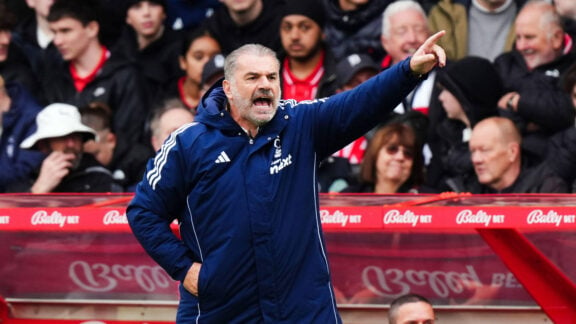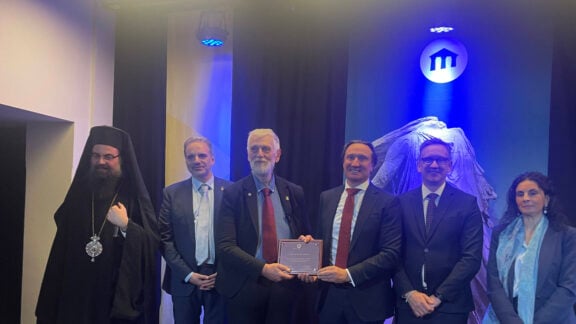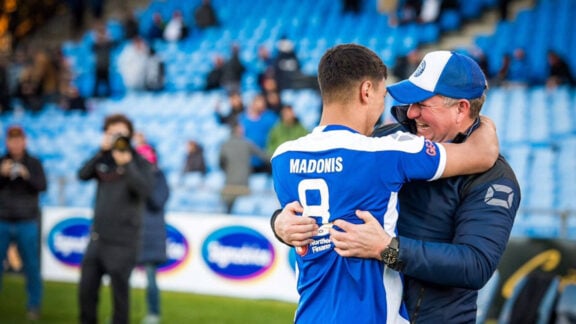Ancient Greeks: Athletes, Warriors and Heroes explores competition in our world, in sports, education, and the arts. It reflects on our heroism in the face of invaders, and in wars amongst our own, as well as our myths.
Dr Withycombe says that the works came with a “suggested framework, and the Museum, then placed the objects in context.”
She has a background in Classical Archaeology, and she has spent a lot of time in Greece. She is a Hellenophile of the first order.
“You try not to get too excited about these exhibitions when they’re on the table, at the beginning, then when it comes to actually opening the crates and seeing the objects, it’s just wonderful, you can’t help but get excited.”
Dr Withycombe said that the project team had been working on the development of this exhibition for two years.
“While the content comes from the British Museum, we must shape it to suit our audiences and fit our main gallery.
“We have been editing the interpretive text and revising the exhibition order, with lots of meetings to workshop this process, as well as back and forth communications with colleagues at the British Museum and we ended up with the perfect layout.”
The design has been based on finding from the NMA’s audience visitor research to ensure the comfort of the Museum’s visitors.
We also re-wrote text as a consideration of the Australian public, which is different to the British Museum, so we must edit things to suit our public.
The Museum strives to make the “exhibition accessible” they don’t use terms like BC or AD, “we want secular terms like Before Christian Era BCE and Christian Era CE, or if I see ‘mankind’ I would always want to make it humankind.”
In Greek of course there is no ‘mankind’, it’s Anthropos, or humankind. Dr Withycombe agrees that often we look at the past through the eyes of modern world and we cannot always truly understand what our ancient forebearers thought.
The exhibition talks of the complex relation Ancient Greeks had to war, sport, society, gender, competition, and art.

“Yes, look at Heracles, I always think about the reason he is doing the twelve labours, is because he’s murdered his wife and children.”
The horror of domestic violence was discussed by our Ancients in their mythology. The act of Hercules was considered as heinous, albeit carried out without his awareness under the influence of Hera.
“This exhibition undermines the idea of only twelve labours for Heracles, which is a much later invention.
“One of the objects in the exhibition is Heracles wrestling with Triton and there is a sea nymph on one side, and it reveals that like there’s no cannon for myth.”
Dr Withycombe loves the relief of the Amazons in battle with the Greeks.
“There’s a beautiful representation of the Amazons, and they are not negative depictions, and I’ve seen lots of negative depictions of the Amazons.
“In this relief of the Greeks fighting the Amazons, the Amazons are shown as incredibly beautiful warriors, and at some point, you don’t know if the Amazons are winning, or the Greeks.”
It is often said that for the Greeks the Amazons may have been depictions of warrior women from the Central Asian Steppes.
In the feverish debates over gender and patriarchy now in the context of ancient Greece, it is often omitted, that Spartan women were involved in martial arts, chose who to have sex with, and were not constrained to gender-based roles – as were their Athenian counterparts.
On the question of the British Museum and the Parthenon Marbles Dr Withycombe says that “Museums everywhere are grappling with issues of providence, and every museum should look at their own collection.”
“None of the objects in this exhibition have a disputed providence”, many of them are from as far as the Black Sea Greek settlements, dating 600 BCE.
As Greeks, we want our culture to be recognised as a universalist one. For example, northern Pakistan is replete with Greek artefacts dating back to the Indo-Hellenic empire. Central Asia is strewn with the remnants of Greek civilisation and there are Hellenes around the Black Sea dating back to 800 BCE.
The exhibition features over 170 objects with artefacts from 800 BCE to 200 CE, West to East, Athens (Αθήνα), to Halicarnassus (Ἀλικαρνασσός) in Anatolia, now Bodrum, Turkey.

Dr Withycombe doesn’t like to name favourites she loves everything in the program. However, when pressed by Neos Kosmos she doffs the hat to NMA director Dr Mathew Trinca who “requested the inclusion of two outstanding addition objects: the so-called ‘Apotheosis of Homer’ relief, which presents an exquisite example of Hellenistic relief marble carving signed by the sculptor Archelaos of Priene; and a black figure amphora by Ezekias, the most famous of all known Attic painters, which shows a powerful scene from the Iliad.”
She names others as well, like the two women playing knucklebones. “It is such an ancient object and yet so real and so contemporary, it could be now, and it shows the life of two ordinary women in Ancient Greece.”
Dr Withycombe has been blessed with a job she relishes – not a job, but a calling.









